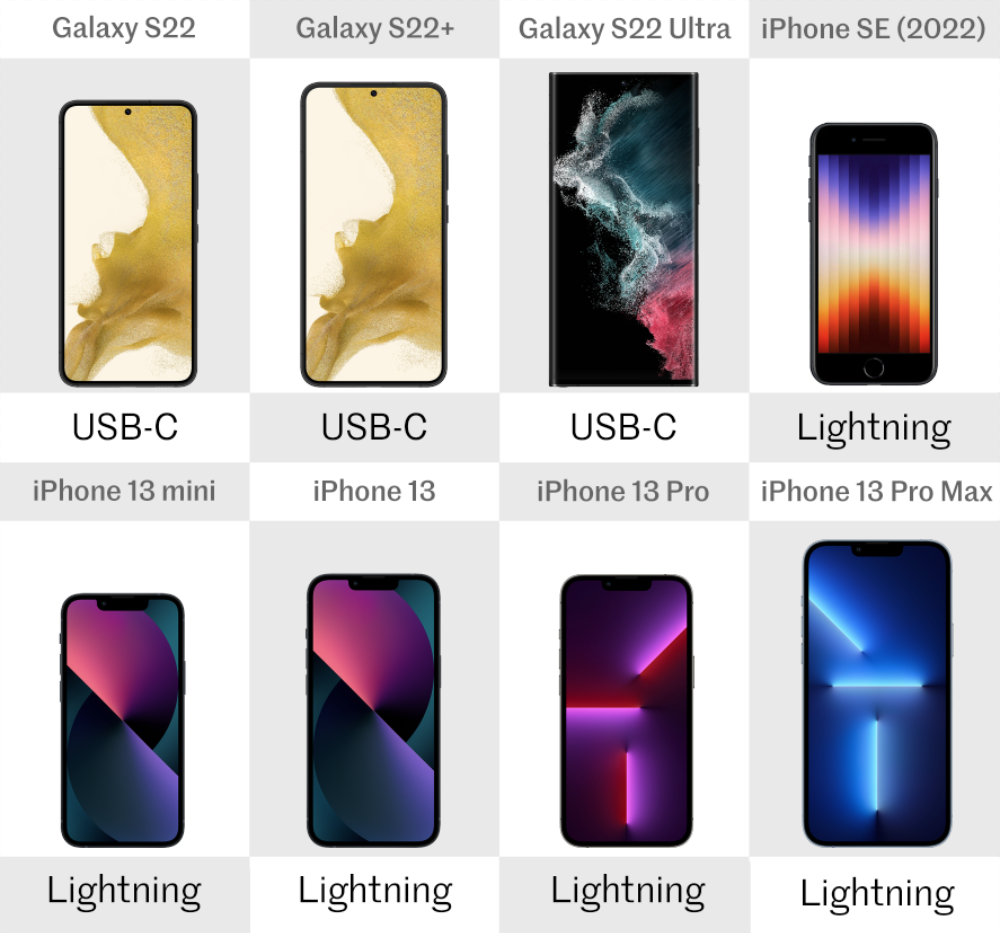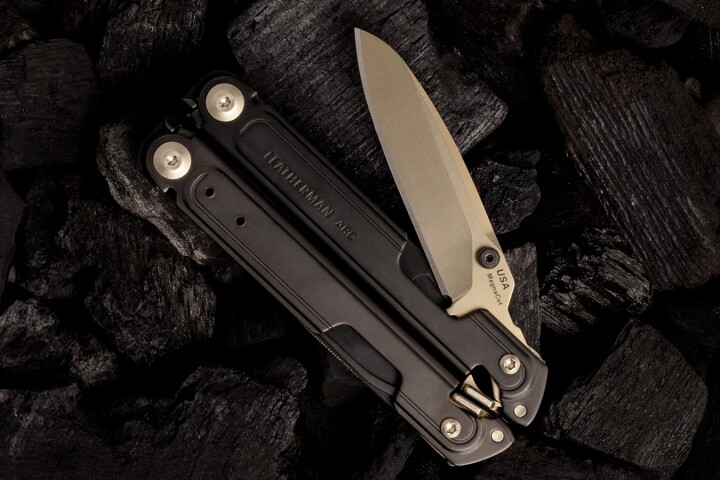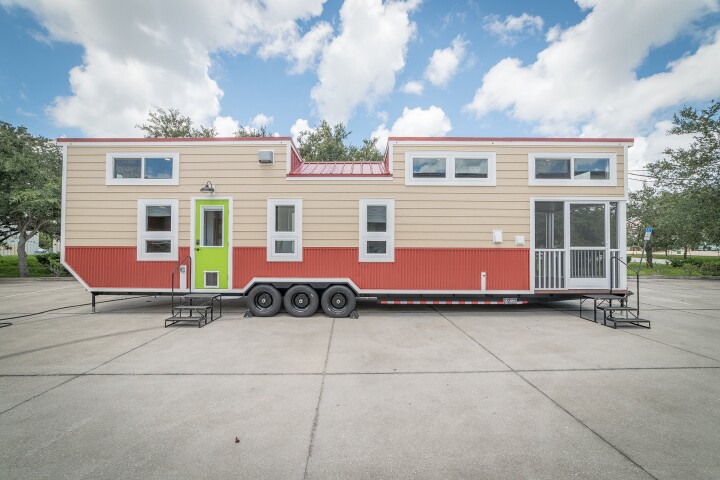The Samsung Galaxy S22 series has landed, but as always, the question is how well do they stack up against the current iPhones? New Atlas compares the specs and features of the Samsung Galaxy S22, S22+ and S22 Ultra to the iPhone SE, iPhone 13, 13 mini, 13 Pro and 13 Pro Max.
At a glance it might be hard to tell which Galaxy corresponds to which iPhone, and it doesn’t help that Apple is now in the business of four mainline iPhones a year. Roughly speaking, the Galaxy S22 and iPhone 13 are comparable, the Galaxy S22+ and iPhone 13 Pro go together, and the Galaxy S22 Ultra and iPhone 13 Pro Max pair up.
That said, the gaps between them vary – the iPhone 13 Pro is only a fraction better than the iPhone 13, while the S22+ is a big step up from the vanilla S22.
And then there are the two “bonus” iPhones, the iPhone SE and 13 mini. The mini is kind of an upper-mid-range phone, with only a few features of the standard 13 stripped out for a lighter price tag. The SE sacrifices a bit more – particularly style – but is still a very capable device for a fraction of the cost.Size

The iPhone 13 mini is, as you might expect, the smallest phone of the bunch. That’s followed by the iPhone SE, about 7 mm taller and 3 mm wider. The next size up, which is 8 mm taller and 3 mm wider, is close to a three-way tie between the iPhone 13, 13 Pro and Galaxy S22.
Next in line is the Galaxy S22+, which is 11 mm taller and 4 or 5 mm wider than the previous batch. The iPhone 13 Pro Max is 3 mm taller and wider than that. And finally the Galaxy S22 Ultra is the biggest of the bunch, another 3 mm taller than the iPhone 13 Pro Max (although a hair narrower).
Weight-wise, the iPhones are all slightly heavier than their Galaxy counterparts. The iPhone 13 mini is the lightest of course, followed closely by the iPhone SE. The iPhone 13 is 6 or 7 grams heavier than the Galaxy S22, the 13 Pro is 8 or 9 g heavier than the S22+, and the iPhone 13 Pro Max is 11 or 12 g heavier than the S22 Ultra. For reference, a US nickel coin weighs exactly 5 grams.
The multiple weights for the Galaxies is down to which 5G version they use – more on that later.Colors

Most of these phones come in standard black and white options, although their respective companies give them fancier-sounding names – Samsung goes for “Phantom” White or Black, while Apple goes for Starlight (white) or Midnight (black).
For a bit more color, Samsung offers green on all three Galaxies, as well as pink gold on the S22 and S22+, or burgundy on the Ultra. Apple offers red on the iPhone SE, 13 and 13 mini, as well as blue or pink on the latter two. And for the Pro and Pro Max, it tries to class things up with graphite, gold, silver and a pastel Sierra Blue.Build

All eight phones are made with glass front and black, ringed in metal – aluminum on the Galaxy series and the iPhone SE, 13 and 13 mini, and stainless steel for the iPhone 13 Pro and Pro Max.
The iPhones (bar the SE) have been strengthened by what Apple calls a Ceramic Shield, which protects the screen against scratches and cracks. Samsung has a similar thing it calls Aluminum Armor, but that mostly applies to the frame. The glass is Corning’s Gorilla Glass Victus+ though, so it should be similarly hardy to drops.
All eight phones also have a decent degree of dust and water resistance. The three Galaxies and four iPhone 13 models are all rated IP68, which officially means they can be dunked to a depth of 1.5 m (4.9 ft) for up to 30 minutes. Apple goes a step further and says the iPhone 13 series can dive as deep as 6 m (20 ft). The iPhone SE is only rated IP67, but that still means it can survive immersion down to 1 m (3.3 ft).
In practice, those water resistance ratings are more of a guide than anything, and we wouldn’t recommend testing them out. However, it’s good to know that your phone – whichever one you might get – should shake off a spill or an accidental dunk no problem.Display

OLED displays are the industry standard at the moment, which should provide brighter colors and deeper blacks than IPS LCD. Apple was the last major holdover for LCD tech, but even it has now finally moved over to OLED in recent generations – except that is, for the iPhone SE.
That’s not the only way the SE is living in the past – in fact, its entire design seems to be stuck in 2017. That was the last time flagship iPhones had such small screens and big bezels, and we can’t help but wonder if Apple is deliberately keeping its budget model old-school so no one would dare mistake it for a modern flagship.
Anyway, as mentioned the iPhone SE has the smallest display at a puny 4.7 in, followed by the iPhone 13 mini at 5.4 in. After that it’s a three-way tie between the iPhone 13, 13 Pro and Galaxy S22 on a more modern 6.1 in.
Next is the Galaxy S22+ on 6.6 in, followed closely by the iPhone 13 Pro Max on 6.7 in. And finally the Galaxy S22 Ultra leads the pack with a huge 6.8 in screen.
The screen-to-body ratio of these phones is concentrated between 85 and 90 percent, thanks to the small borders of each device. The Galaxies fare slightly better than the iPhones, because they house their cameras inside a tiny “hole punch” in the screen, while Apple is still going for the bigger “notch” style that eats into the screen real estate more.
The big exception of course is the iPhone SE, which has the body of an iPhone 8 – almost 35 percent of the front of the device is taken up with chunky black bars housing the camera, speakers, microphone and a physical home button. How quaint.Display resolution

Unsurprisingly, the iPhone SE has the lowest resolution of the bunch, with a screen that barely scrapes past the 720p mark. It’s also got the lowest pixel density at 326 pixels per inch (ppi).
Next in line is a three-way tie between the Galaxy S22, S22+ and iPhone 13 mini, on 2,340 x 1,080 – a bit over Full HD resolution. The pixel densities here vary on account of the different display sizes on each phone.
Another step up is the iPhone 13 and 13 Pro, with a few hundred more pixels crammed in. The iPhone 13 Pro Max goes bigger again, with a roomy 2,778 x 1,284 pixels. And the leader of the pack is the Galaxy S22 Ultra, on a huge 3,088 x 1,440 pixels and a detailed pixel density of 500 ppi.
The iPhone SE, 13 and 13 mini have refresh rates of just 60 Hz, which to some eyes might start to seem a bit jittery. The iPhone 13 Pro and Pro Max, as well as all three Galaxy models, bump this up to a silky smooth 120 Hz.
Both companies’ phones can display in high dynamic range (HDR), but the iPhones use HDR10 while the Galaxies go for HDR10+. The latter technology is designed to give greater contrast between dark and bright areas of the screen, and dynamically adjusts settings while content is playing, rather than just doing so once at the beginning of a video.Processor

The Galaxy phones are all running Qualcomm’s latest chipset, the Snapdragon 8 Gen 1. The iPhones of course are powered by Apple’s latest processor, the A15 Bionic.
RAM-wise, the iPhone SE gets by on just 4 GB, while the iPhone 13 and 13 mini jump to 6 GB. The iPhone 13 Pro and Pro Max, as well as the three Galaxy phones, are running on 8 GB of RAM, which is about standard now for flagship phones. If that’s not speedy enough, the Galaxy S22 Ultra offers a 12 GB option too, but that’s probably overkill for most people’s use.Front camera

If good selfies are important to you, the front-facing camera’s quality could make or break a phone for you. The iPhone SE has the lowest resolution at 7 megapixels (MP), followed by the Galaxy S22 and S22+ at 10 MP. The iPhone 13 range is packing a 12-MP TrueDepth camera, which measures 3D volumes to power functions like FaceID. But the leader of the pack, once again, is the Galaxy S22 Ultra, with a crystal clear 40-MP front camera.Rear camera

Around the back is where the cameras mean business. The iPhone SE has a single camera – a wide-angle 12-MP lens, with an aperture of f/1.8 and 5x digital zoom. The iPhone 13 and 13 mini add a second 12-MP camera, this time an ultra-wide lens that allows for 2x optical zoom out.
The iPhone 13 Pro and Pro Max add a third – a telephoto lens, also 12 MP. This provides 3x optical zoom in and up to 15x digital zoom.
The Galaxy S22 and S22+ have a similar setup of three cameras – wide, ultra-wide and telephoto lenses – but their megapixel counts are all over the place. The ultra-wide camera is 12 MP like the iPhones, while the telephoto is 2 MP lower. However, the wide-angle camera has a far higher resolution of 50 MP. Their zoom is better too, up to 3x optical and 30x digital.
The Galaxy S22 Ultra adds a fourth camera, a second 10-MP telephoto lens, which boosts its zoom up to 10x optical and 100x digital.Photo modes

Whether Galaxy or iPhone, many of the same photo modes are available regardless. They just might have different names.
High dynamic range (HDR), where cameras can capture bright lights and dark shadows in the same shot, is available across all eight phones. Samsung uses HDR10+ while Apple calls its version Smart HDR4.
They all have portrait mode, where users can adjust the level of background blur to make the subjects pop. They can all stitch together multiple shots into panoramas. They can all shoot under low-light conditions – which Apple calls Night mode and Samsung calls Nightography. They can all display augmented reality (AR), where virtual objects and characters are displayed over the real world.
Both companies have a feature where a few seconds of video are captured before a photo is snapped – Samsung calls it Motion Photo, Apple’s version is Live Photo.
Samsung’s Detail Enhancer and Apple’s Deep Fusion are similar processes too, capturing more detail in the shot. The Galaxies achieve this using AI while the iPhones do so by overlaying multiple exposures.
Samsung’s Scene Optimizer function automatically recognizes what’s in frame – including modes like food, faces, sunsets, landscapes and animals – and adjusts settings to get the best results. Apple’s Photographic Styles is similar, except it allows users to set certain settings as favorites that then apply to all photos taken.
Samsung also has a mode called Single Take, where a range of different types of images are captured at once, such as video, stills and loops, so that users can then decide which mode worked best for that moment.Video modes

Likewise, many of the video modes are the same across Apple and Samsung devices. They can all shoot in 4K resolution at 60 frames per second (fps), Full HD at 60 fps and 720p HD at 30 fps. In addition, the iPhones can shoot 4K at 24, 25 or 30 fps and Full HD at 25 or 30 fps.
The Galaxy phones can also shoot video with 8K resolution, something that few other phones can manage. The problem is, not many people actually have 8K TVs, so the feature might be lost on most users.
All eight phones can shoot in slow motion at 240 fps with Full HD resolution. The iPhones can also do so at 120 fps, while the Galaxies can slow things down even further to 960 fps.
Going the opposite direction, all of these phones can shoot timelapse videos too. And they all have forms of optical and electronic image stabilization (OIS/EIS).
They can all shoot in HDR, but the iPhone 13 range has a major advantage here. They can apply Dolby Vision – an HDR grading technique – to videos in real time, something that even professional film cameras can’t do.
Another iPhone exclusive is Cinematic mode, which automatically focuses and tracks a subject through a video, and can shift that focus when another subject enters the frame. Focus and blur depth can also be adjusted after a video has been shot.
And finally, the iPhone 13 Pro and Pro Max can shoot natively in ProRes, Apple’s proprietary video format. The company claims this provides higher color fidelity and lower compression.Biometrics

The iPhone 13 range can be unlocked using Apple’s FaceID system, while the iPhone SE uses a fingerprint sensor embedded in the physical home button. The Galaxy phones feature both, with their fingerprint sensor an ultrasonic version hidden in the lower section of the display.Storage

All eight of these phones are available with built-in storage capacities of 128 or 256 GB. The iPhone SE also offers a smaller 64 GB option, while the iPhone 13 and 13 mini go up to 512 GB. The Galaxy S22 Ultra, iPhone 13 Pro and Pro Max come with up to 1 TB. That might seem excessive for many people’s daily use, but remember that those fancy new video modes could chew up space quicker than you might expect.
Also note that none of these devices have MicroSD cards, so choose your capacity carefully because you won’t be able to expand it later.Battery

In pure capacity numbers, Apple devices always look a little lacking – perhaps that’s why the company never officially discloses those figures. As such, each iPhone’s battery capacity is quite a bit lower than its corresponding Galaxy. The iPhone SE hasn’t yet been determined, but rumor has it that it’s a little over 2,000 mAh. In practical terms however, you should expect to get at least a full day’s use out of any of these phones.
All of these phones can be fast charged and wirelessly charged, although you’ll need to buy a wireless charger separately – and in the case of the iPhones, a separate fast charger too.
The Galaxy phones also have a fast wireless charging option, and a feature called Wireless Powershare, where the phones can wirelessly charge other devices placed on top of them.5G

All eight phones have 5G connectivity, allowing for faster cellular internet speeds. However there are slight differences – the iPhone 13 range taps into a version of the tech called mmWave, which is the fastest available at the moment. The iPhone SE uses another system called sub6, which is a little slower but still faster than 4G.
Galaxy phones come in different models that can connect to either mmWave or sub6, depending on your region and carrier. That’s also the reason for the slight differences in weight between the same models, as mentioned earlier.Ports

The Samsung phones all have USB-C ports, while the iPhones use Apple’s proprietary Lightning ports.Operating system

These phones are all running the latest versions of their respective operating systems – that’s Android 12 for the Galaxy phones, and iOS15 for the iPhones.Release date

The iPhone 13 series has been out the longest, having released back in September 2021. Samsung released its Galaxy S22 line in February 2022, while the new iteration of the iPhone SE followed a month later.Price

As expected, the iPhone SE is the least expensive phone of the bunch, by quite a margin. In fact, you could splurge on the roomy 256 GB version and still pay a lot less than the next phone in line – the iPhone 13 mini, which starts at a reasonable US$699.
The Galaxy S22 and iPhone 13 both start at $799 for the 128 GB models, while you can double that storage for an extra 50 bucks for the S22 or $100 for the iPhone 13. It’s a similar deal to upgrade the next rung up the ladder, the Galaxy S22+ and the iPhone 13 Pro, both starting at $999 for 128 GB.
Things are different for the flagships, with the Galaxy S22 Ultra $100 more expensive than the iPhone 13 Pro Max. At least, that’s for the 128 and 256 GB models – after that, their 512 GB or 1 TB models are the same prices.
With all that in mind, are you on team Galaxy or iPhone? If you still can’t decide, check out our other phone comparisons.






















